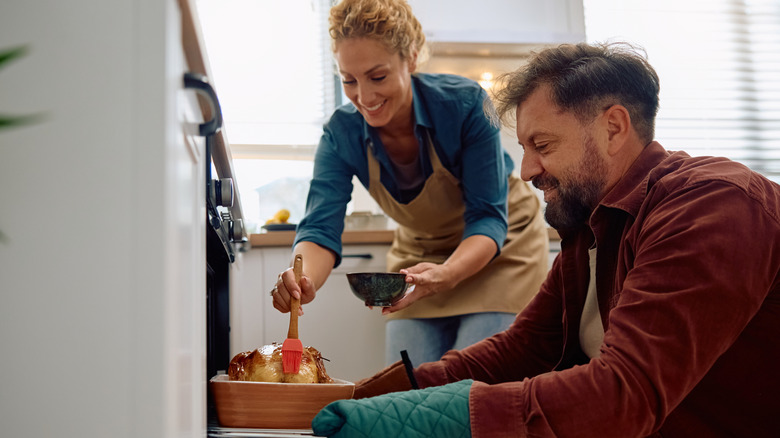Basting Works Wonders, Just Not For Your Turkey
Basting is a cooking technique often used to moisten a dish by spreading meat juices, sauce, or marinade over the surface as it cooks. It's a common step in many roasted turkey recipes. According to its proponents, basting is the best way to avoid a dry bird. But all too often, after carefully basting throughout the cooking process, home chefs are still left with tough, dry, and flavorless turkey meat. That's because, according to many chefs and food safety experts, basting is not an effective moistening technique with a whole turkey, and it can even lead to the spread of bacteria.
Standard basting isn't effective when roasting a whole turkey because the flavoring ingredients struggle to penetrate most of the meat. However, basting can work well when preparing smaller meat portions such as pork chops, chicken, and steak. For example, butter-basting steak is a technique used by many chefs to give maximum flavor when pan-searing. It can also be used for eggs. By basting fried eggs in oil, you can create a flavorful and crispy outside for this simple breakfast dish.
If you're looking to serve a juicy and crisp roast turkey, brining or salting are much better options. So skip the basting when you're making a whole turkey, and save it for another day!
Why you shouldn't baste your turkey
Basting your turkey is counterproductive. Opening the oven door periodically to brush the turkey drops the oven temperature, extending the overall cooking time. The extra time in the heat of the oven further dries out the meat, which is the opposite of the intent when basting.
On top of pushing the start of dinner further back, basting doesn't do you any favors with the flavor. While the idea is that basting adds moisture to dry meat, the turkey doesn't absorb much of the basting liquid. Instead, it runs over the surface of the turkey, not reaching the center. And continually adding moisture to the outside stops the skin from becoming crisp and golden.
Worst of all, basting turkey can lead to food safety concerns. As you brush the meat with basting liquid, the basting tools and the remaining liquid can become contaminated with bacteria from the raw poultry. Even as the bird bakes off that harmful bacteria, you're brushing it back on to baste. If you serve the turkey before the basting mixture reaches 165 degrees Fahrenheit, you risk digesting that bacteria and possibly getting a foodborne illness.
Why you should brine instead of basting
So, if you aren't basting turkey, you're likely curious about how to add flavor and moisture. A great option to keep the meat juicy on the inside with a crispy outer layer is to brine the turkey. Brine is a saltwater solution that includes other flavoring ingredients. Soaking the turkey in brine ahead of the big day is an excellent way to enhance the overall taste and texture. The salt in the brine breaks down some of the proteins in the meat so that it can better absorb the moisture and flavors.
It's important to remove the turkey from the brine so that it has time to dry before cooking. While you want moisture inside the meat, the dryer the outer layer is, the more it can crisp up in the oven. To keep your turkey moist, it's also essential not to overcook. If you dried out your bird by overcooking it, you can use butter stock as a trick to moisten the dry turkey.


